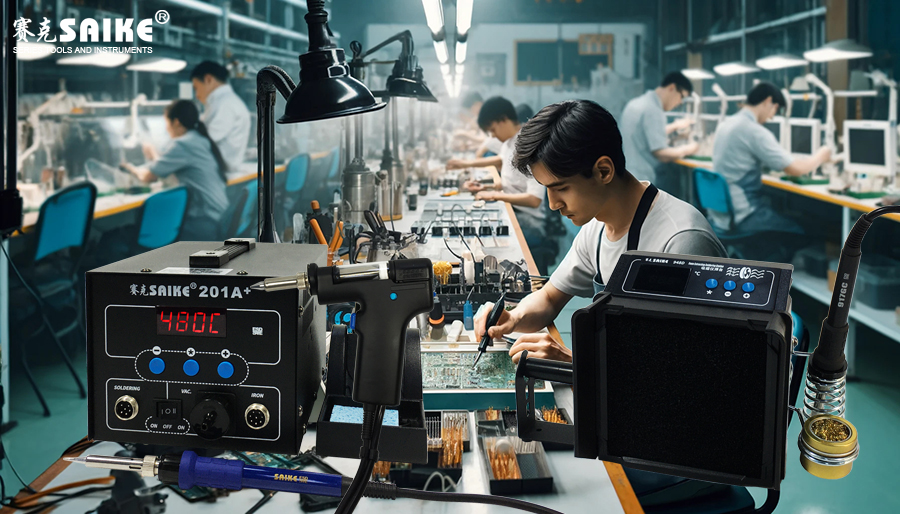
SK-YJ000HT-KP 100022
Soldering station tools are indispensable equipment for electronic manufacturing and maintenance work, and their proper use is crucial to ensure soldering quality and efficiency. This article will introduce the basic components, operating skills, maintenance methods, and common problem-solving strategies of soldering station tools in detail.
I. Basic Components of Soldering Station Tools
The soldering station usually includes the following main components:
– Power Supply and Temperature Control Unit: Provides and regulates the power and temperature required for the soldering iron.
– Soldering Iron: The main body of the soldering tool, used to directly transfer heat to the solder and workpiece.
– Soldering Tip: Installed at the end of the soldering iron, it directly contacts the solder and workpiece, coming in various shapes and sizes.
– Stand and Cleaning Sponge: Used to place the soldering iron when not in use, often equipped with a cleaning sponge to clean the soldering tip.
– Auxiliary Tools: Such as solder suckers, pliers, scissors, etc., used to assist in the soldering process.
II. Methods for Using Soldering Station Tools
1.Power-on and Preheating
– Power-on: After ensuring that the power cord is safely and correctly connected, turn on the power switch of the soldering station.
– Preheating: Set the desired soldering temperature and allow the soldering station to preheat to the set temperature. The preheating time is usually within a few minutes, depending on the type of equipment and the set temperature.
2.Preparing for Soldering
– Cleaning the soldering tip: Use a cleaning sponge or copper wire ball to remove the oxide layer and old solder from the soldering tip before soldering.
– Applying flux: Apply a moderate amount of flux to the parts that need to be soldered to help remove the oxide layer and improve soldering quality.
3.Soldering Operation
– Applying solder: Lightly touch the solder wire to the junction of the soldering iron tip and the part to be soldered, allowing the solder to melt and flow to the soldering joint.
– Operating skills: Keep the soldering iron tip at a 45-degree angle to the work surface. The solder should first come into contact with the workpiece rather than the soldering iron tip to ensure uniform heating of the soldering joint.
– Completing the soldering: Once the solder fully covers the soldering joint and forms a good soldering shape, quickly remove the soldering iron to avoid overheating.
4.Post-soldering Processing
– Cleaning: Use cleaner and a brush to clean the soldering area, removing excess flux and solder slag.
– Inspection: Check whether the soldering joint is intact and there is no cold soldering or false soldering.
III. Maintenance of Soldering Station Tools
– Regular cleaning: Regularly clean the soldering tip and remove residual solder and flux after use.
– Storage: After use, return the soldering iron to the stand, turn off the power, and ensure that the workbench is tidy and orderly.
– Replacing the soldering tip: Regularly replace the soldering tip according to its wear to ensure soldering quality.
IV. Solving Common Problems
– Cold soldering: This is usually caused by too low soldering temperature or insufficient heating of the soldering joint. The solution is to increase the soldering station temperature or extend the heating time.
– Solder balling: This may be due to too high soldering station temperature or too short contact time between the solder and the soldering joint. Adjust the temperature or improve soldering skills.
V. Conclusion
The correct use and maintenance of soldering station tools are crucial to ensure the success of electronic equipment soldering operations. By following the aforementioned usage methods and maintenance strategies, soldering efficiency can be improved, equipment lifespan can be extended, and soldering quality can be ensured. Operators need to continuously adjust and optimize the soldering process according to specific soldering requirements and equipment characteristics.


